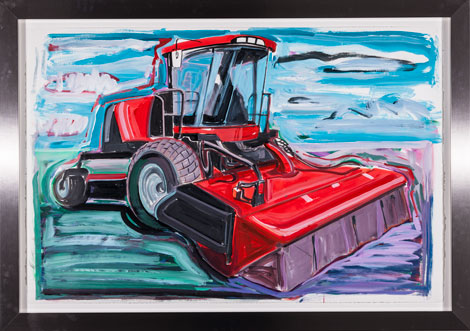Karen Carson has a tremendous sense of humor, as is evidenced in her most recent exhibition at Rosamund Felsen. Having chosen farming equipment—most prominently, tractors—as her subject matter, Carson revels in the sheer monumentality and vibrant colors of these exquisite forms. Whoever would have thought tractors could be so compelling?
Carson’s large-scale images are painted directly onto unstretched canvas and are hung unframed on the gallery walls, further emphasizing their unfettered masculinity. Each image exists within the framework of its own individual character and identity, as though these machines were unique and beautiful in their own right.
The humor comes into play in the style in which they are conceived. Loose and playful, Carson’s tractors are mild-mannered behemoths, stilled momentarily within the picture frame, yet strangely sexy in their garishness and bravado. If they were alive, à la Transformers, they’d have names like Jake and Buck, identities that have come to embody our idea of the “new” American frontier, an agricultural landscape that is being continually reshaped by these new-fangled machines.
Big Friend (New Holland Tractor) (all works 2013), for example, is so seemingly affable, the viewer momentarily forgets it’s a machine at all; despite their more obvious illustrative appearance however, there lurks a deeper resonance that speaks to mechanization, such that we’ve lost touch with essential human qualities including how we process the foods we eat. Perhaps we’ve also sacrificed our intuition, and day-to-day human experience, at the altar of commerce. Emerging from rural Montana where Carson resides, her images seem to stem from her life experience living with and among these swathers, balers and huskers day in and day out.
Carson’s machines practically transform into something strangely sinister and otherworldly. Lumbering and looming over us, they also appear as though they are posing like supermodels at the forefront of industry, showing off their unique individual traits and skills. Chase International Swather, for instance, could be second cousin to Stephen King’s famously possessed Plymouth Fury, Christine, as the machine seems poised for action yet vaguely menacing in its authority and formidable posture. Also, the operators of these massive tractors are all but missing from the scene and are only ever hinted at through Carson’s use of shadow, further suggesting a kind of omnipotence in the mechanism.
Carson’s studies for these large paintings are equally compelling, if a bit looser, than their large-scale counterparts. Corn Combine, for example, is seen in profile, the wheels a bit smaller and oddly misshapen. Studies For Case International are even more intimate and loosely rendered; seen together, these smaller drawings become more about movement in space and time and less focused on the monumentality and physical weight of the objects themselves. Instead, they operate as more intimate portraits.
Finally, Carson’s vision is so winning one wishes to simply crawl into the driver’s seat of these giant threshers and away we’ll go, even despite their massiveness and the fact they move slowly, albeit with tremendous and sometimes menacing purpose.


